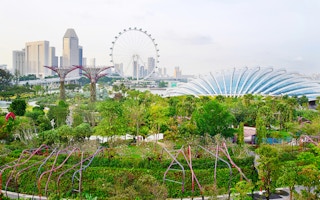Housing, migrant labour and ethnic diversity were some key issues raised during a recent lecture held in Singapore on whether the city-state could manage to be both a globally competitive, and a socially just city. However, the role of sustainability as essential to achieving this balance between competitiveness and justice was conspicuously absent from the discussion, despite the fact that practices such as energy efficiency, resource conservation and urban greenery help cities achieve their economic and social objectives.
Ignoring sustainability in a conversation about urban planning is a missed opportunity for developing truly holistic and workable solutions to help cities balance economic growth with social inclusiveness.
It is also worrying that such high-level, influential discussions on inclusive urban growth see sustainability as tangential to the equation, when it is in fact, at the core of the issue.
Competitive and just? Or just competitive?
The talk, held on Thursday by the Centre for Liveable Cities, on “Singapore’s dilemma as a city state: Global City or Just City” was delivered by Professor Susan Fainstein, of the Harvard Graduate School of Design and Professor Norman Fainstein of the Connecticut College in the United States.
Professor Susan Fainstein explained to the 200-strong audience her theory of ‘a just city’, which identifies democracy, diversity and equity as the three essential characteristics of a city that ensures justice for all residents, especially low-income groups. She pointed out that the lack of diversity of opinions in the public sphere, and the inequality experienced by groups such as migrant labourers were some of the barriers to Singapore being a just city.
The concept of the ‘just city’ was presented as a remedy to the ills of neoliberal capitalism, which is the political and economic system where growth is a top priority and it is assumed that free market processes will ensure social, political and economic stability.
It is the prevalent economic and political system in most global cities today. The 2008 global financial crisis and the on-going violence in Ukraine due to anti-government sentiment were raised as examples by Professor Norman Fainstein of economic and political crises caused by inadequately regulated neoliberal capitalism.
But beyond economic and political consequences, the unchecked capitalism of the past decades has also created environmental crises across the world, including climate change, rapid mining of natural resources, widespread pollution and the increasing scarcity of food and water resources. However, the issue of sustainability did not feature at all in the discussion of balancing growth with equity.
This has to be part of the debate; sustainability has to be central in the discourse on inclusive growth because not only does continued growth depend on the continued availability of resources for conducting commerce, but focusing on resource and energy conservation, low-carbon transport options, minimising industrial pollution and preserving the natural environment can also help achieve equitable outcomes.
These include reducing costs of living for residents, making all parts of the city more accessible to diverse groups of people, and inspiring community participation in cause-oriented initiatives that shape the city’s landscape.
“
Singapore, with our unique set of land and resource constraints, dependence on trade and imports, and challenges of balancing the needs of a rapidly growing (and diversifying) population with economic growth, is a prime example of how factoring sustainability into policy and urban planning can help a city achieve the status of ‘globally competitive city’ and ‘just city’ at the same time.
When this issue was posed as a question to the speakers, Professor Susan Fainstein cited an example of resilience-building efforts such as how restoring wetlands displaced the disempowered occupants, to illustrate how sustainability could also be used as a smokescreen for further exploitation. She later acknowledged that sustainability was “critically important” to justice, but attributed its absence analysis to firstly, her lack of expertise in environmental sciences, and secondly, that an environmental lens introduced too much complexity to an already challenging examination of social, economic and political pathways to justice.
Singapore, with our unique set of land and resource constraints, dependence on trade and imports, and challenges of balancing the needs of a rapidly growing (and diversifying) population with economic growth, is a prime example of how factoring sustainability into policy and urban planning can help a city achieve the status of ‘globally competitive city’ and ‘just city’ at the same time.
Inequality in wealth and power is one of the most pressing and visible signs of injustice in a city; in Singapore, the issue has come under renewed scrutiny due to international coverage by the BBC (Singapore’s hidden poverty problem) and the Guardian (Unaffordable cities: Singapore workers tread water on millionaires’ island).
With rising income inequality and inflation, those at the bottom of the income ladder face difficulties in coping with increased costs of living, including utility costs, food prices and transport costs. Implementing sustainable practices to increase energy and water efficiency, and increase the availability of affordable public transport, for example, can help reduce the cost burden on low-income groups.
One campaign that seeks to address this, for example, is the SWITCH With Maybank @ Central Singapore, which engages volunteers to provide low-income households in the Central Singapore District with energy efficient lightbulbs. Organised by Central Singapore Community Development Council (CDC), the National Environment Agency (NEA), and Maybank Singapore, the programme installed its 4000th energy-saving lightbulb in the Central Singapore district in December 2013. According to NEA, the families benefiting from these schemes collectively saved $160,000 in utilities bills annually.
Transport is also a key consideration for shaping an inclusive city. Affordable transport is necessary for people to access economic and social opportunities, regardless of income levels. The high cost of car ownership in Singapore excludes it from being a viable option for low-income groups in Singapore, leaving public transport, walking or cycling as possible options.
Again, if sustainability were to be a key consideration in planning a city’s transport infrastructure, it would yield low-carbon solutions such as affordable and extensive public transport, walkable spaces and safe routes for cyclists – these very solutions would also be low-cost, and remove financial or logistical barriers for city dwellers gain access to professional and social opportunities.
Both Professors concluded that justice and competitiveness are not irreconcilable goals in Singapore. They repeatedly (and rightly) emphasised the need for measures to improve the conditions of migrant labour such as construction workers and domestic helpers, and revising land use patterns to reduce class segregation between various income groups and meet these dual objectives.
There is no doubt that these measures must be implemented to achieve a more inclusive and equitable Singapore.
However, it is also essential that academics, policy makers and city planners give equal validity to goals such as preserving urban greenery and biodiversity, reducing greenhouse gas emissions, reducing natural resource consumption through reducing consumerism and increasing energy efficiency.
They are crucial pieces of the puzzle as well, without which Singapore cannot be a competitive, flourishing city that is also an inclusive, just home for all its residents.


















